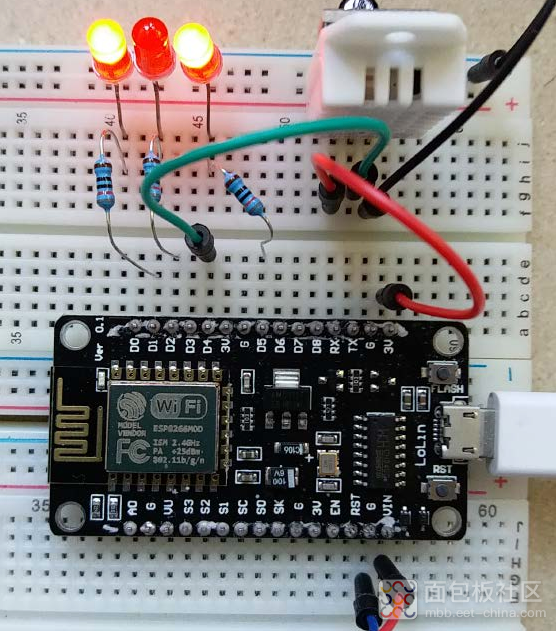這個手機的wifi 小玩意,的英文從這個randomnerdtutorials点com 網站下載的裡面有詳細資料。
我加入了。
1. 一個 DHT22 。
2. 加多一個 LED 。
3. 更改固定 IP 地圵。
4. 更攺按鍵顏色。
這是用手機通過無線網絡內網控制 ESP12E 輸出 3 個 LED 及 1 個 DHT22 溫度濕度在手機顯示。
LED 輸出可更攺為繼電器輸出控制家電開關。
如有須要可加入其它功能,曾加或減少。
下載用 Arduino 便可以。要在 Arduino IDE 中安裝 ESP12 板。

连线实物图

点灯

手机截图
如何在 Arduino IDE 中安裝ESP8266/************************************************************* 从这个网更改的,詳细請看这网 Completeproject details at http://randomnerdtutorials点com ****************************************************************/ // Load Wi-Fi library #include <ESP8266WiFi.h> unsigned long previousMillis = 0; unsigned long currentMillis = 0; const long interval = 4100; float temp; float humi; float temp1; float humi1; #include <Wire.h> #include <DHT.h> #define DHTPin 2 #define DHTTYPE DHT DHT dht(DHTPin, DHT22); // Replace with your network credentials const char* ssid = "xxxxxxxx"; //????更攺自巳的wifi名稱 const char* password ="xxxxxxxx"; //????更攺自巳的密码 // Set web server port number to 80 WiFiServer server(80); // Variable to store the HTTP request String header; // Auxiliar variables to store the currentoutput state String output0State = "OFF"; String output1State = "OFF"; String output2State = "OFF"; // Assign output variables to GPIO pins const int output0 = 14; const int output1 = 4; const int output3 = 5; // Set your Static IP address IPAddress local_IP(192, 168, 1, 167);//????更改自已IP,这里是固定IP地址,每次开机都是这个地圵. // Set your Gateway IP address IPAddress gateway(192, 168, 1, 1); IPAddress subnet(255, 255, 255, 0); IPAddress primaryDNS(8, 8, 8, 8); //optional 可不用更改 IPAddress secondaryDNS(8, 8, 4, 4);//optional 可不用更改 //---------------------------------------------------------------------------------- void setup() { //Initialize the output variables as outputs pinMode(output0, OUTPUT); pinMode(output1, OUTPUT); pinMode(output3, OUTPUT); //Set outputs to LOW digitalWrite(output0, LOW); digitalWrite(output1, LOW); digitalWrite(output3, LOW); //////////Serial.begin(9600); //要不要都可以,试机时加入 //-------------------------------------------------------------------------------- dht.begin(); // Configures static IP address if(!WiFi.config(local_IP, gateway, subnet, primaryDNS, secondaryDNS)) { /////////// Serial.println("STA Failed to configure"); } //Connect to Wi-Fi network with SSID and password ///////////Serial.print("Connecting to "); ///////////Serial.println(ssid); WiFi.begin(ssid, password); while (WiFi.status() != WL_CONNECTED) { delay(500); ////////////Serial.print("."); } //Print local IP address and start web server /////////////Serial.println(""); ////////////Serial.println("WiFi connected."); ////////////Serial.println("IP address: "); ////////////Serial.println(WiFi.localIP()); server.begin(); } //------------------------------------------------------------------------------- void loop(){ //4sec read dhl22 one time currentMillis = millis(); if(currentMillis - previousMillis >= interval) { previousMillis = currentMillis; temp1 = dht.readTemperature(); humi1 = dht.readHumidity(); if (!(isnan(humi1) ||isnan(temp1))) { temp=temp1; humi=humi1; } } //----------------------------------------------------------------------------------------- WiFiClient client = server.available(); // Listen for incomingclients if(client) { // If a new client connects, //////////////Serial.println("New ClientX1."); // print a message out in the serialport String currentLine =""; // make aString to hold incoming data from the client while (client.connected()) { // loop while the client's connected // Serial.println("New ClientX2."); if (client.available()) { // if there's bytes to read from the client, char c = client.read(); // read a byte, then ///////////////Serial.write(c); // print it out the serialmonitor header += c; if (c == '\n') { // if the byte is anewline character // if the current line isblank, you got two newline characters in a row. // that's the end of the clientHTTP request, so send a response: if (currentLine.length() == 0) { // HTTP headers always start with a response code (e.g. HTTP/1.1 200 OK) // and a content-type so the client knows what's coming, then a blankline: //----------------------------------------------------------------------------------------------- client.println("HTTP/1.1 200 OK"); client.println("Content-type:text/html"); client.println("Connection: close"); client.println("Refresh: 10"); client.println(); //--------------------------------------------------------------------------------------- // turns the GPIOs on and off if (header.indexOf("GET/0/on") >= 0) { //////////// Serial.println("GPIO 0 on"); output0State ="ON"; digitalWrite(output0, HIGH); } else if (header.indexOf("GET /0/off") >= 0){ ////////////Serial.println("GPIO 0 off"); output0State ="OFF"; digitalWrite(output0, LOW); } else if (header.indexOf("GET /1/on") >= 0) { //////////// Serial.println("GPIO 1 on"); output1State ="ON"; digitalWrite(output1, HIGH); } else if (header.indexOf("GET /1/off") >= 0) { //////////// Serial.println("GPIO 1 off"); output1State ="OFF"; digitalWrite(output1, LOW); } else if (header.indexOf("GET /2/on") >= 0) { ////////////Serial.println("GPIO 3 on"); output2State ="ON"; digitalWrite(output3, HIGH); } else if (header.indexOf("GET /2/off") >= 0) { ////////////// Serial.println("GPIO 3 off"); output2State ="OFF"; digitalWrite(output3, LOW); } //------------------------------------------------------------------------------ // Display the HTML web page client.println("<!DOCTYPE html><html>"); client.println("<head><meta name="viewport"content="width=device-width, initial-scale=1">"); client.println("<link rel="icon"href="data:,">"); // CSS to style the on/offbuttons // Feel free to change thebackground-color and font-size attributes to fit your preferences client.println("<style>html { font-family: Helvetica;display: inline-block; margin: 0px auto; text-align: center;}"); client.println(".button { background-color: #195B6A; border-radius:8px; color: white; padding:16px 40px;"); client.println("text-decoration: none; font-size: 14px; margin:2px; cursor: pointer;}"); client.println(".button2 {background-color:#c3352b;}</style></head>"); // Web Page Heading client.println("<body><h4>CONTROL 1 DHT 3 LED</h4>"); client.println("Temp: "); client.println(temp); client.println("C"); client.println(" "); client.println("Humi: "); client.println(humi); client.println("%"); //-------------------------------------------------------------------------------------------------------------------- // Display current state, and ON/OFF buttons // If the output0State is off, it displays the ON button if (output0State=="OFF") { client.println("<p><ahref="/0/on"><button class="button">LED0_OFF</button></a></p>"); } else { client.println("<p><ahref="/0/off"><button class="buttonbutton2">LED0_ON</button></a></p>"); } //----------------------------------------------------------------------------------------------------------------------- // Display current state, and ON/OFF buttons // If the output1State is off, it displays the ON button if (output1State=="OFF") { client.println("<p><ahref="/1/on"><buttonclass="button">LED1_OFF</button></a></p>"); } else { client.println("<p><a href="/1/off"><buttonclass="buttonbutton2">LED1_ON</button></a></p>"); } //--------------------------------------------------------------------------------------------------------------------- // Display current state, and ON/OFF buttons // If the output1State is off, it displays the ON button if (output2State=="OFF") { client.println("<p><ahref="/2/on"><buttonclass="button">LED2_OFF</button></a></p>"); } else { client.println("<p><ahref="/2/off"><button class="buttonbutton2">LED2_ON</button></a></p>"); } //------------------------------------------------------------------------------------------------------------ client.println("</body></html>"); // The HTTP response ends with another blank line client.println(); // Break out of the while loop break; } else { // if you got a newline, thenclear currentLine currentLine = ""; } } else if (c != '\r') { // if you got anything elsebut a carriage return character, currentLine += c; // add it tothe end of the currentLine } } } // Clear the header variable header = ""; // Close the connection client.stop(); //////////////Serial.println("Client disconnected."); } }
复制代码




 /5
/5 


